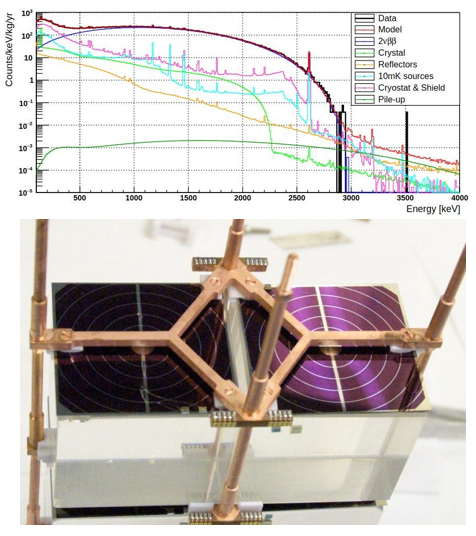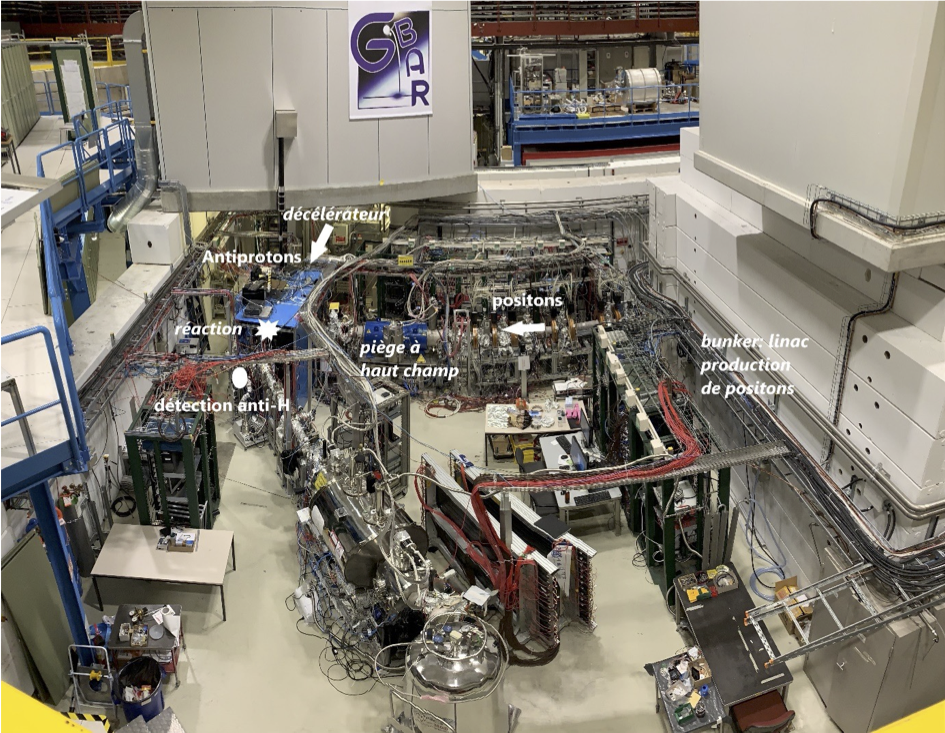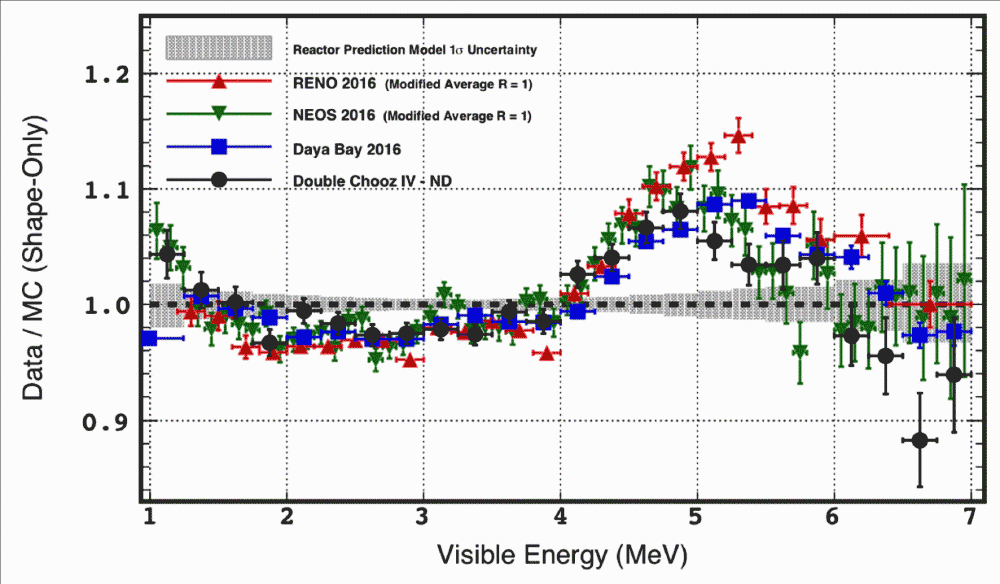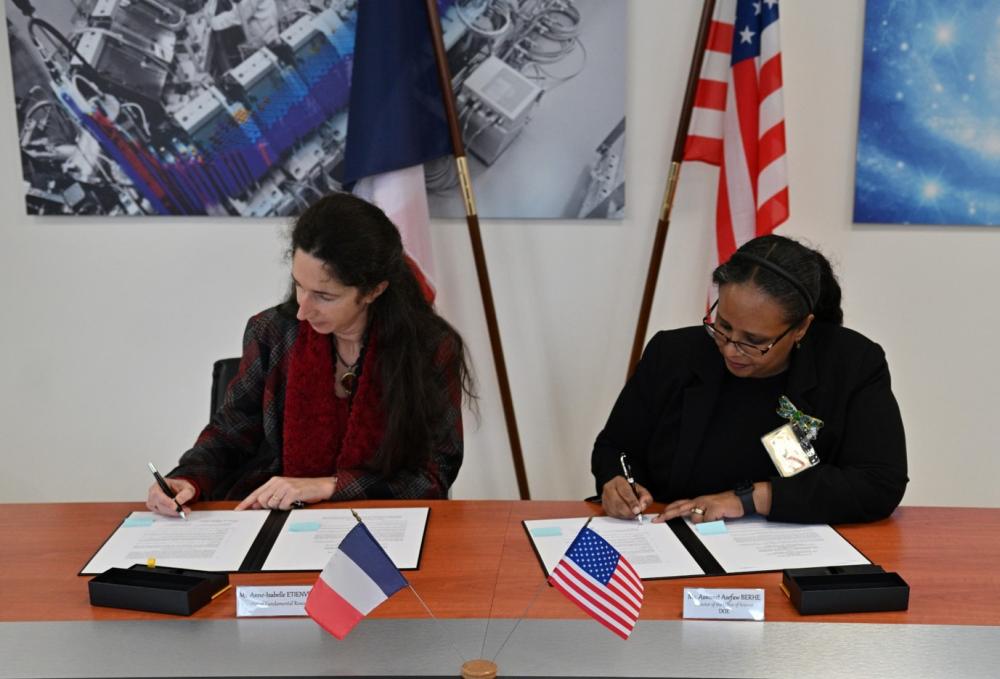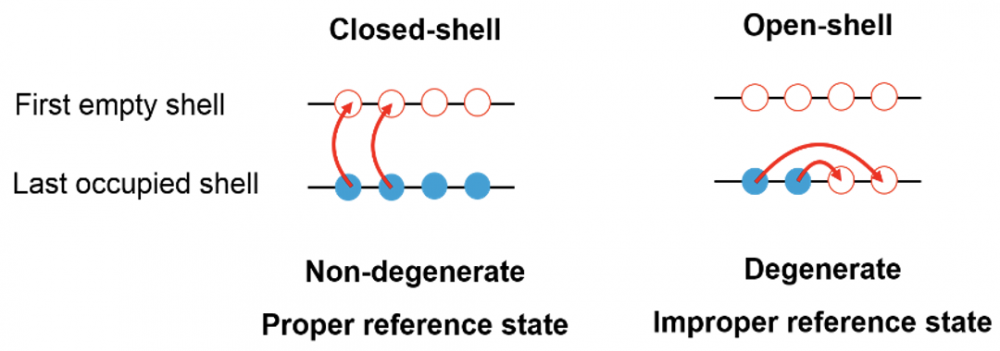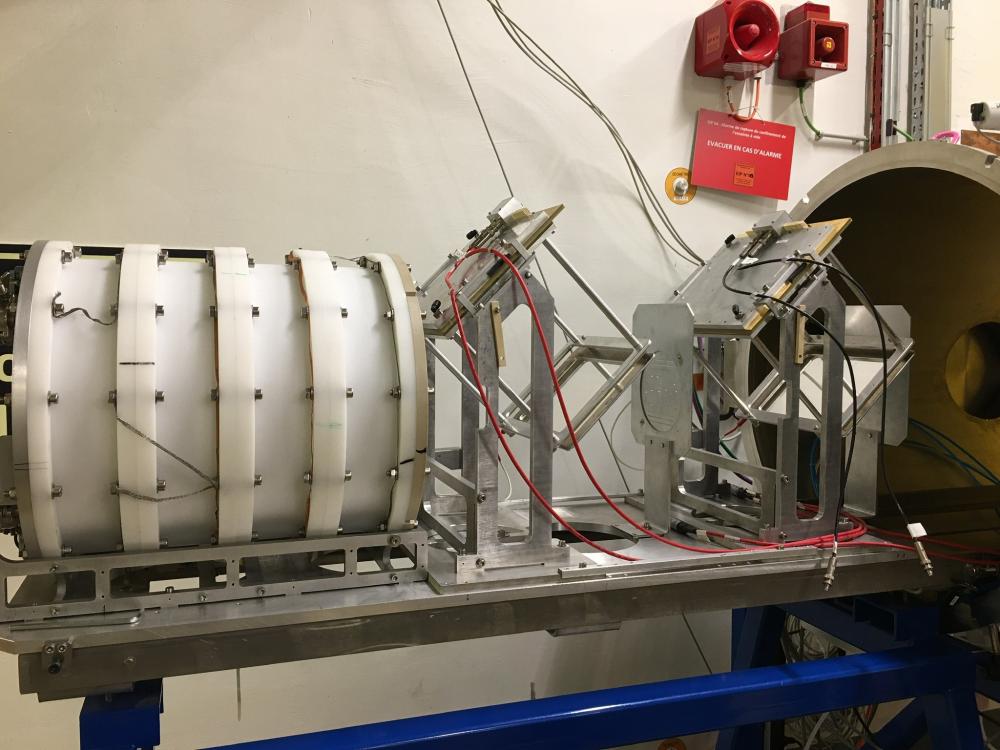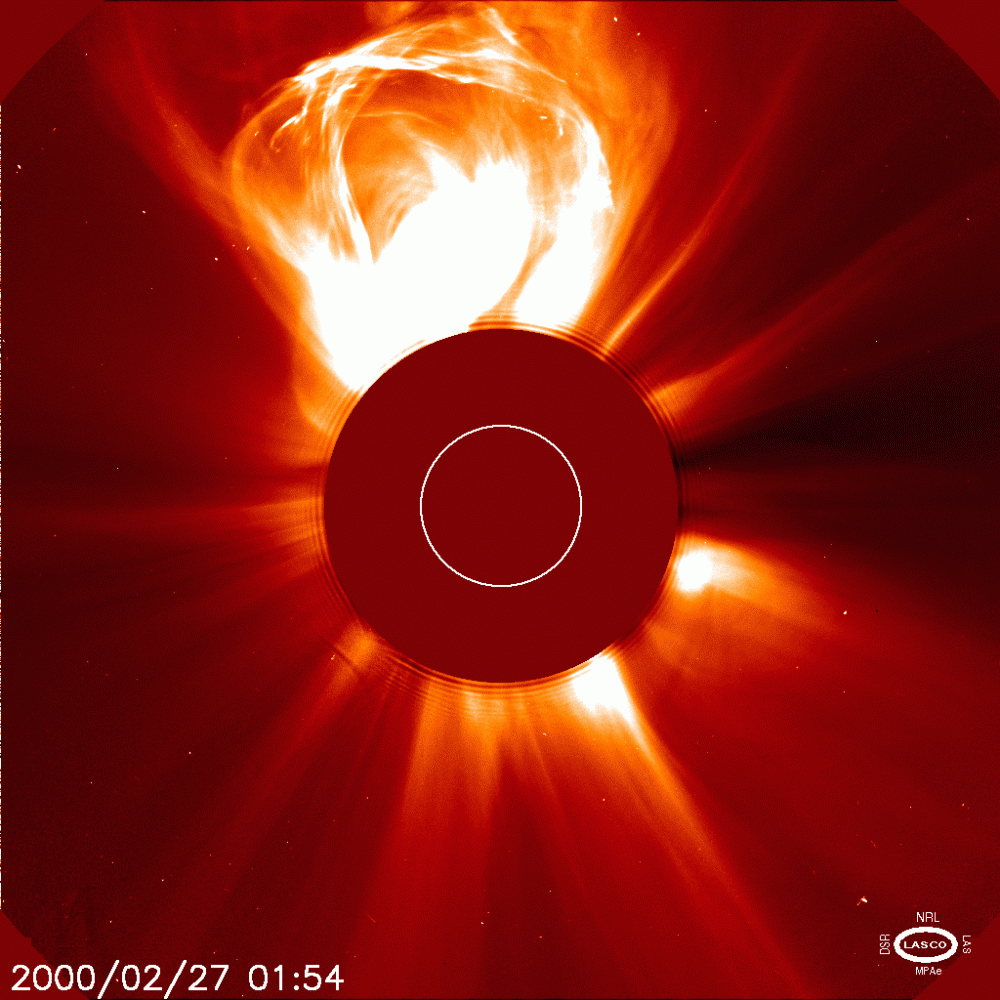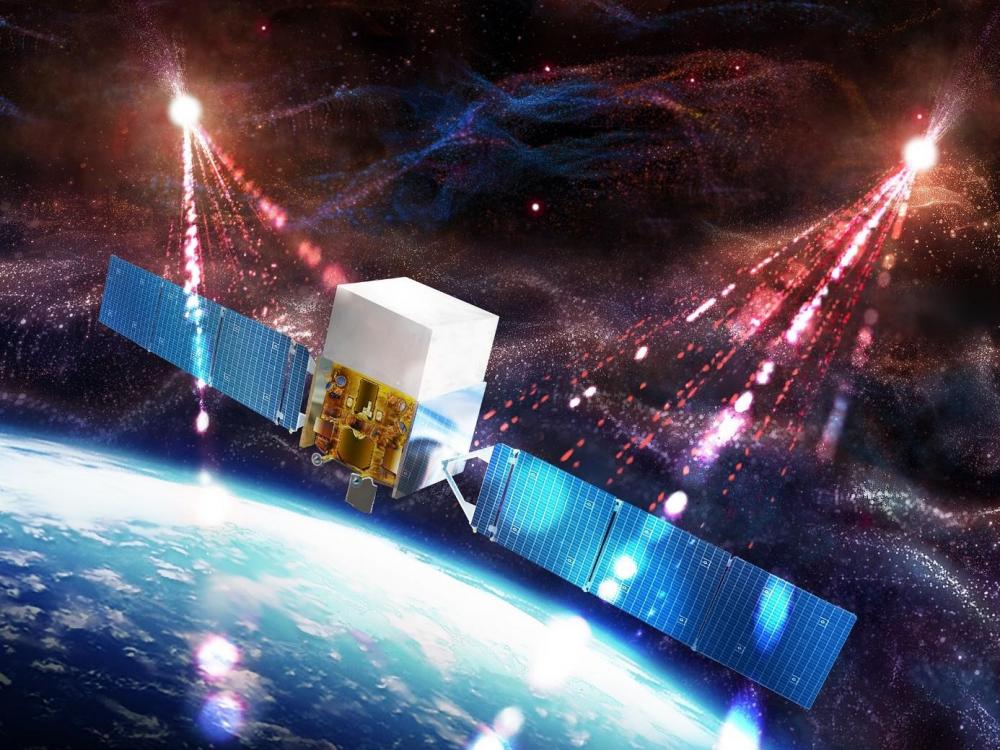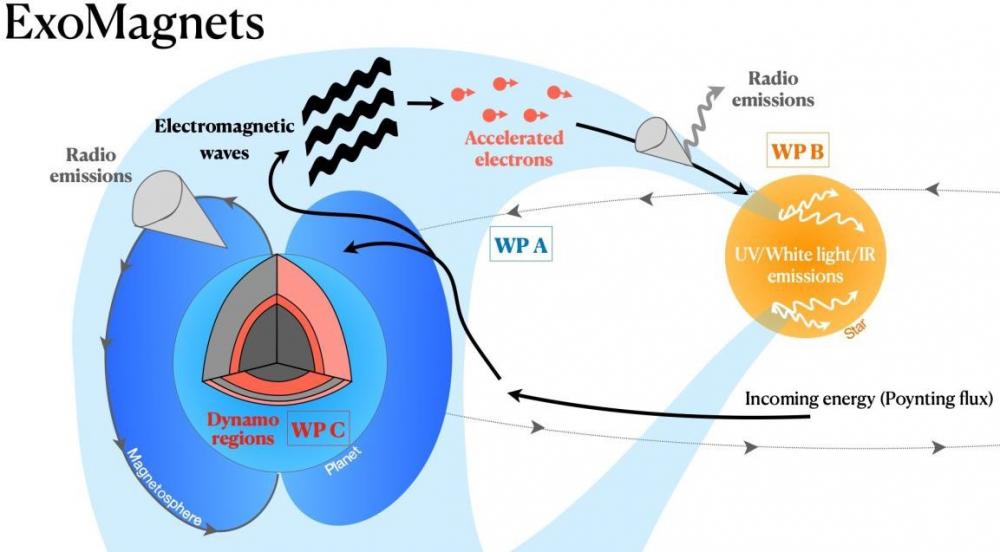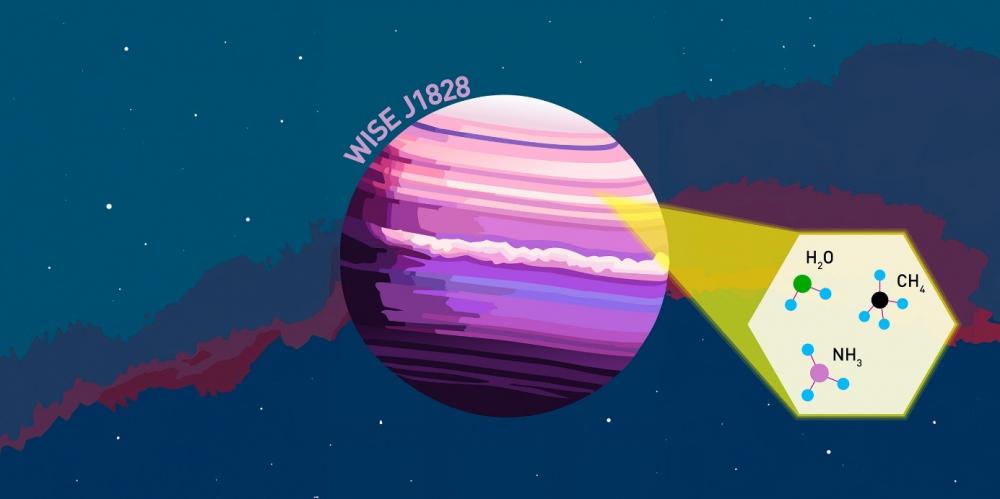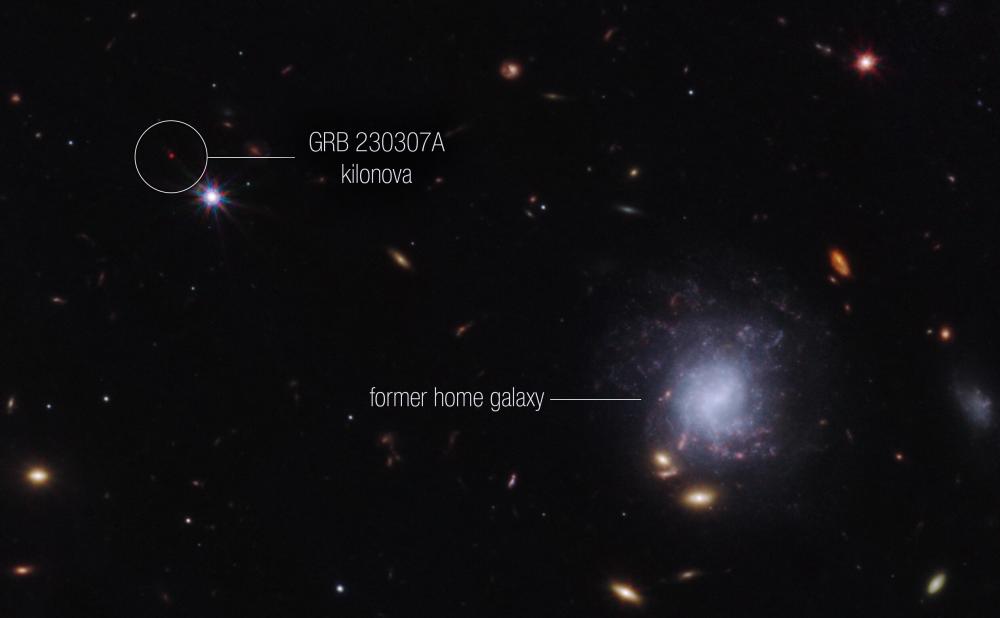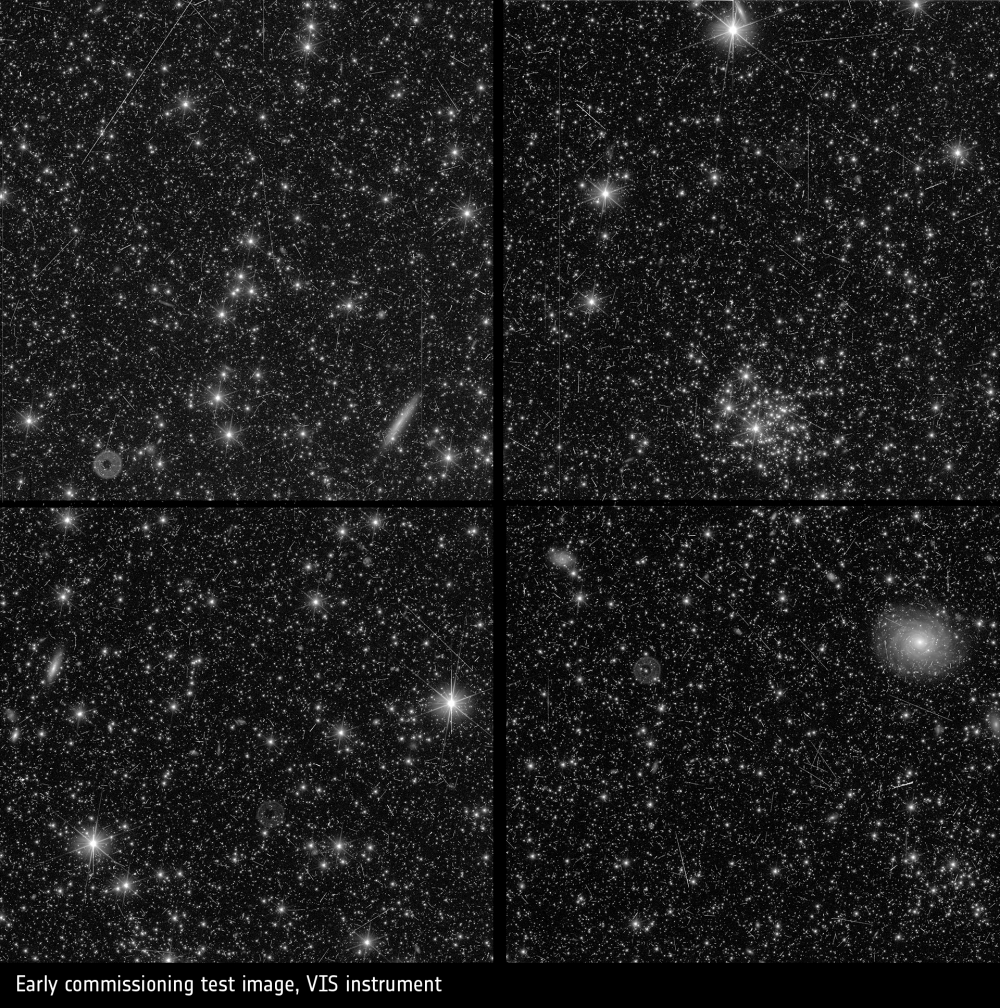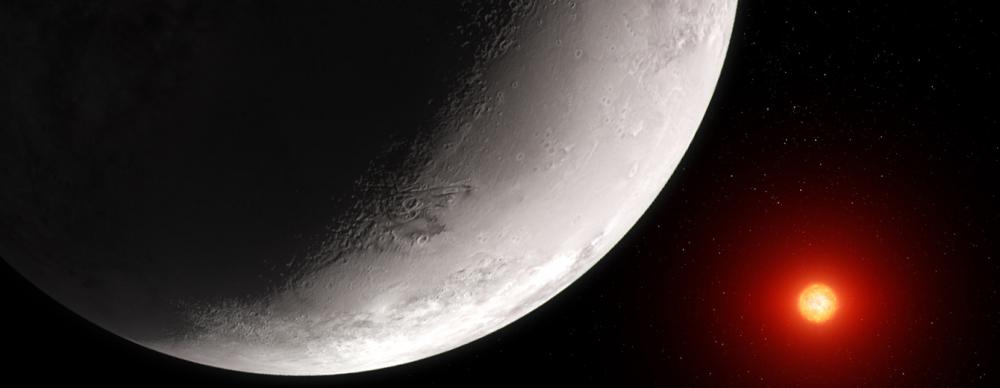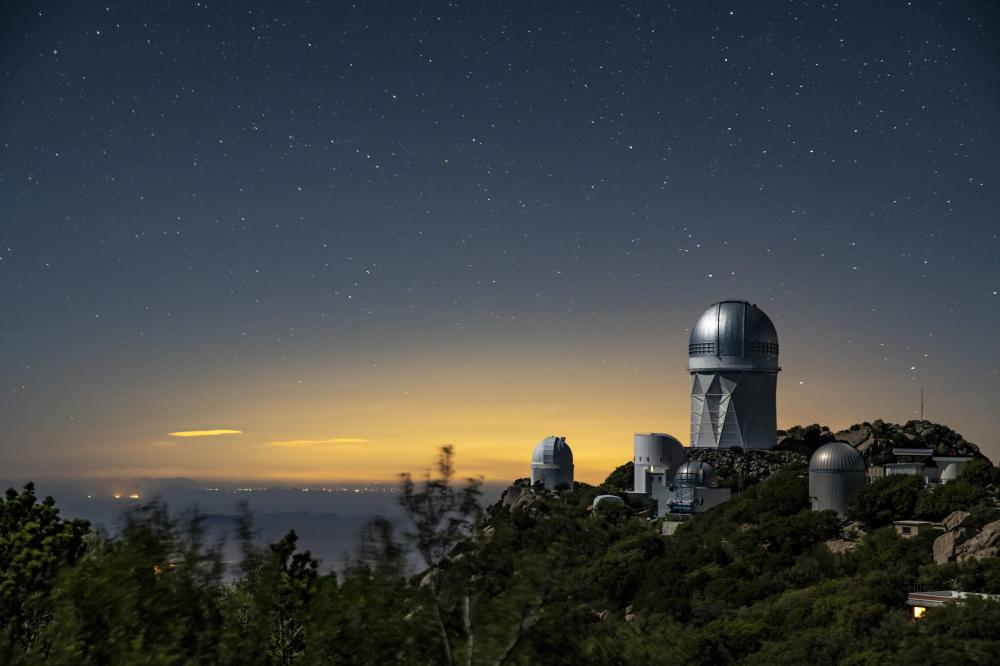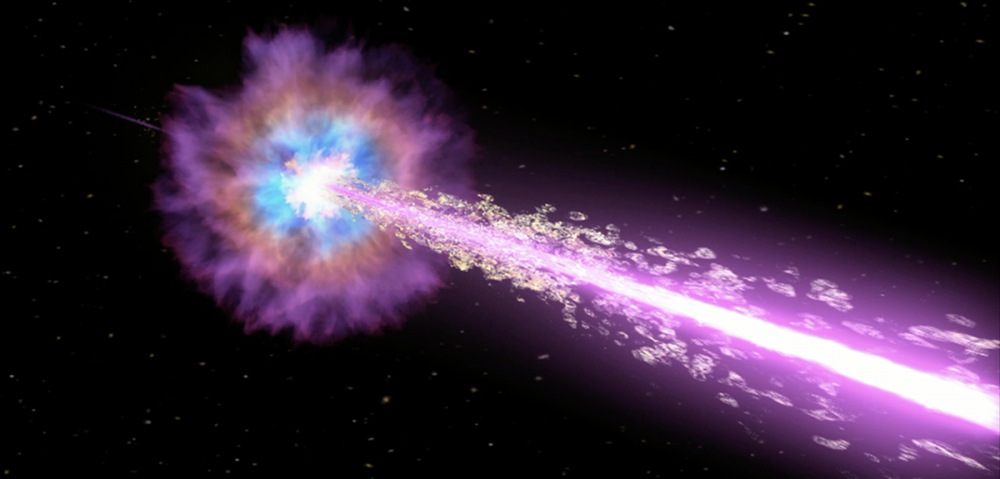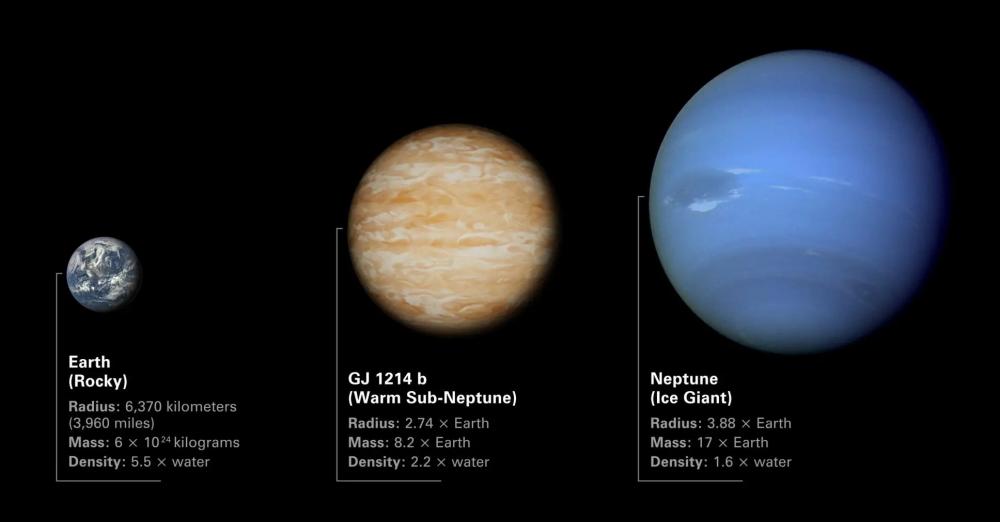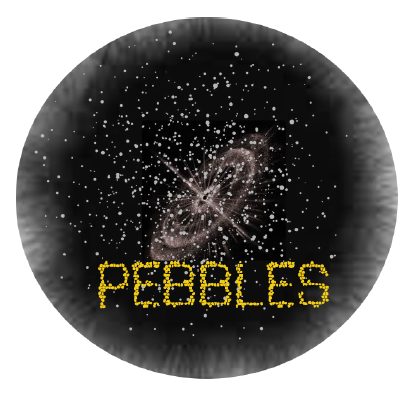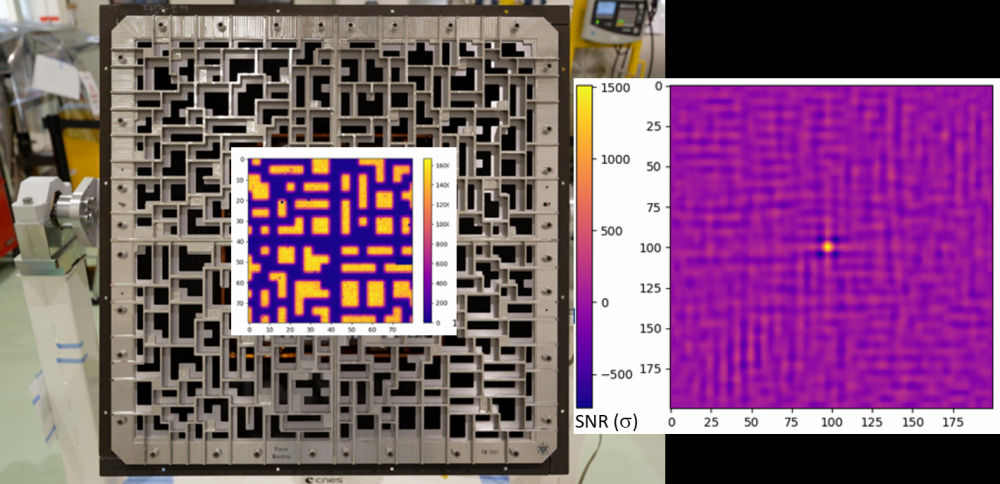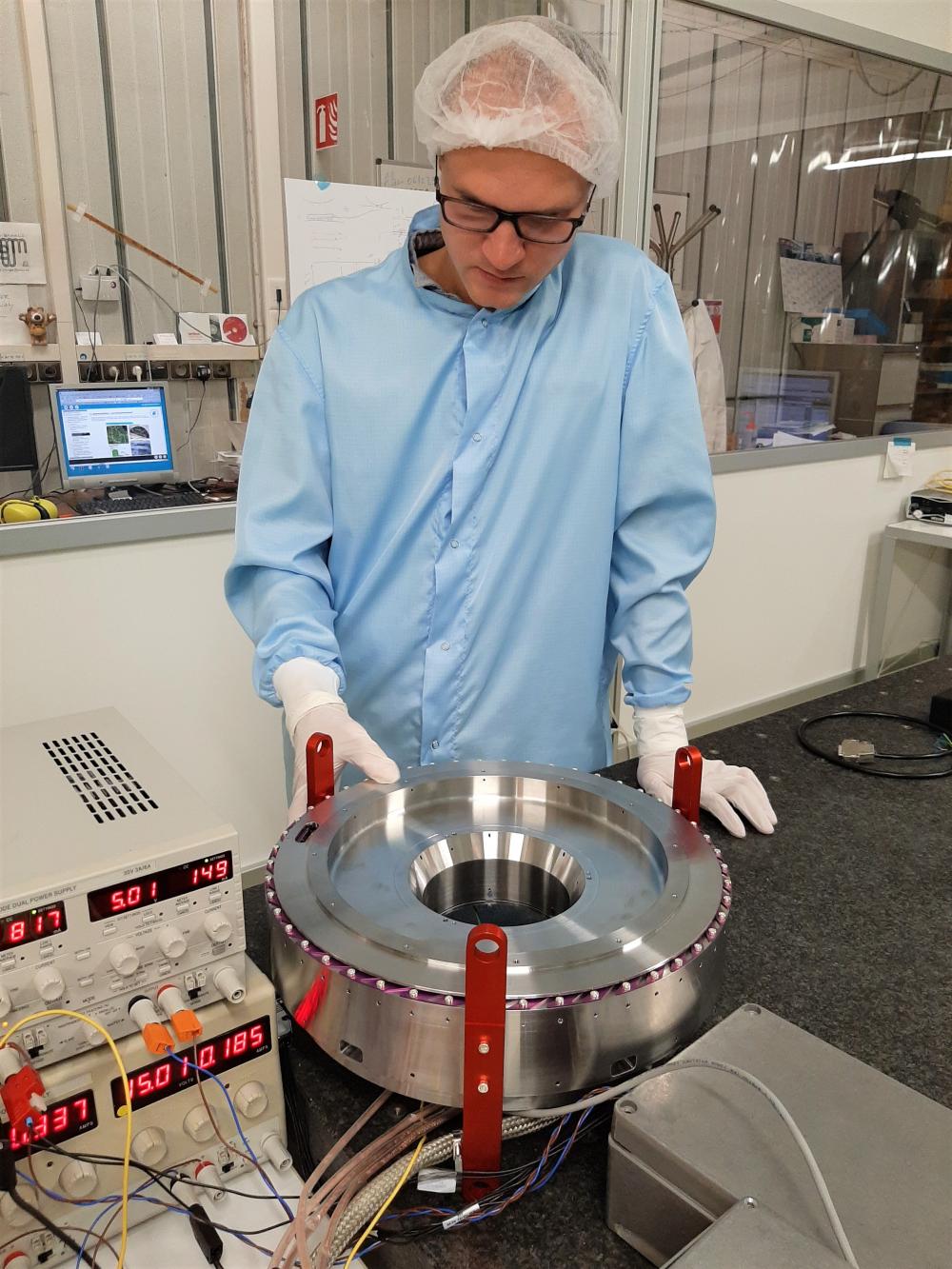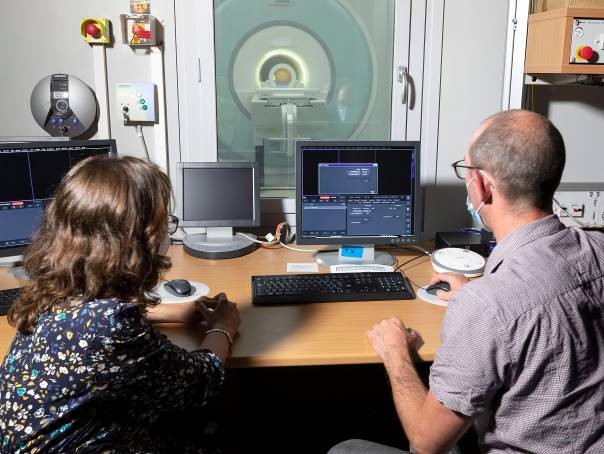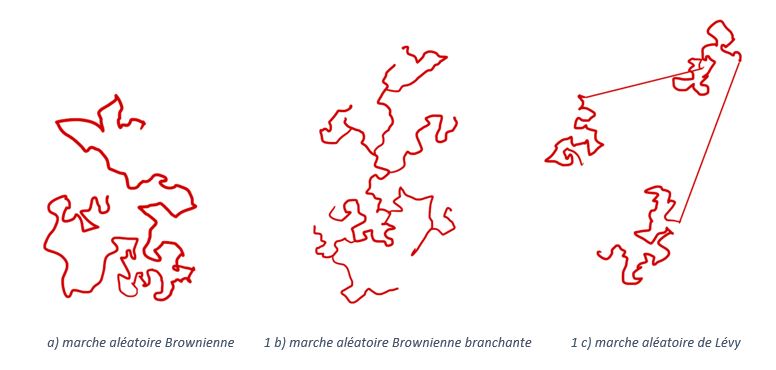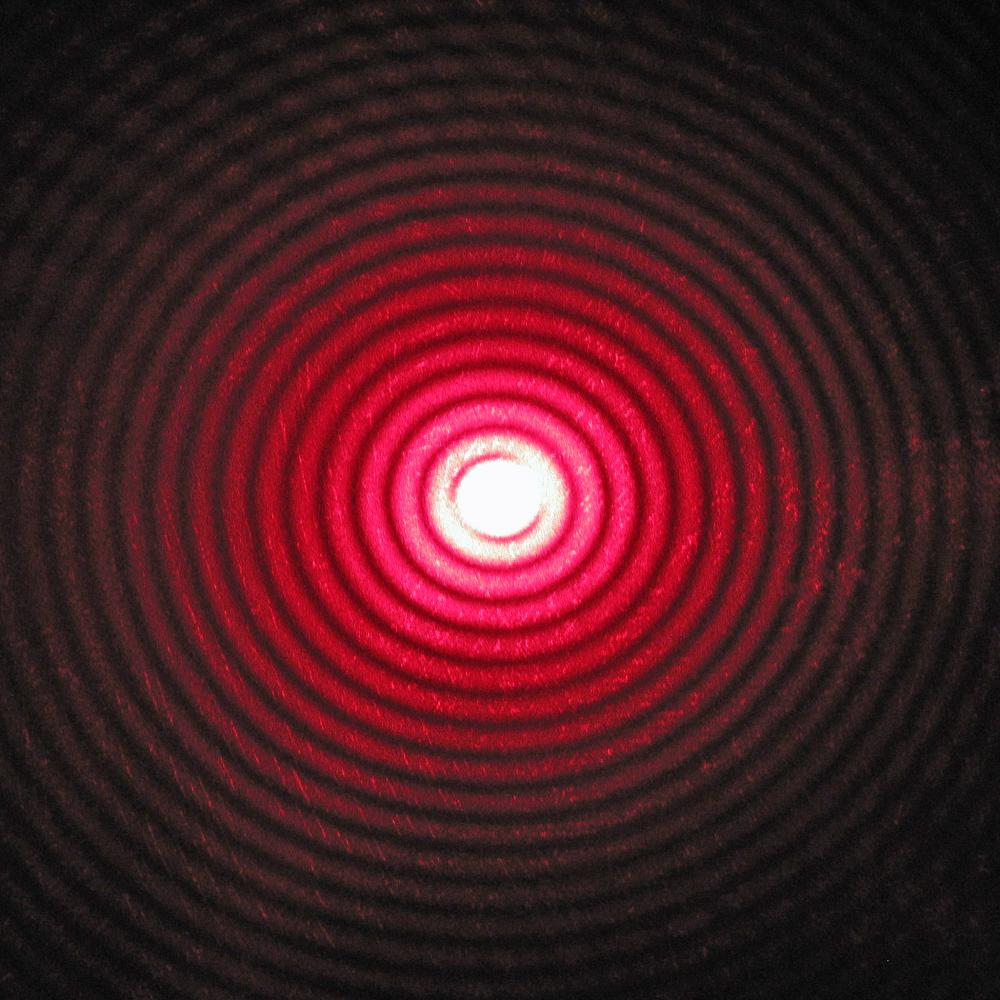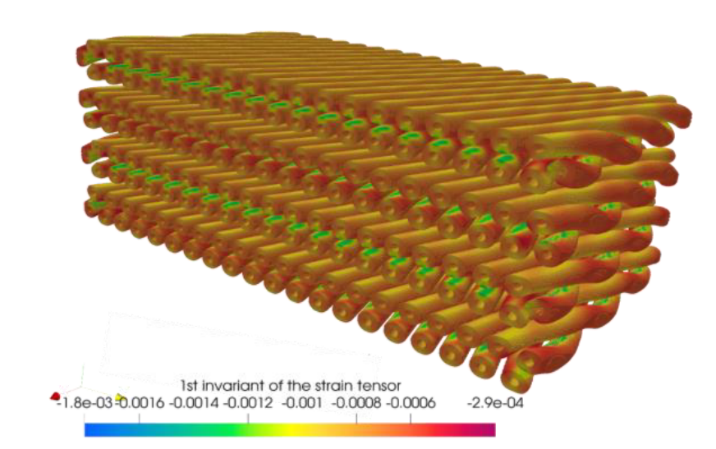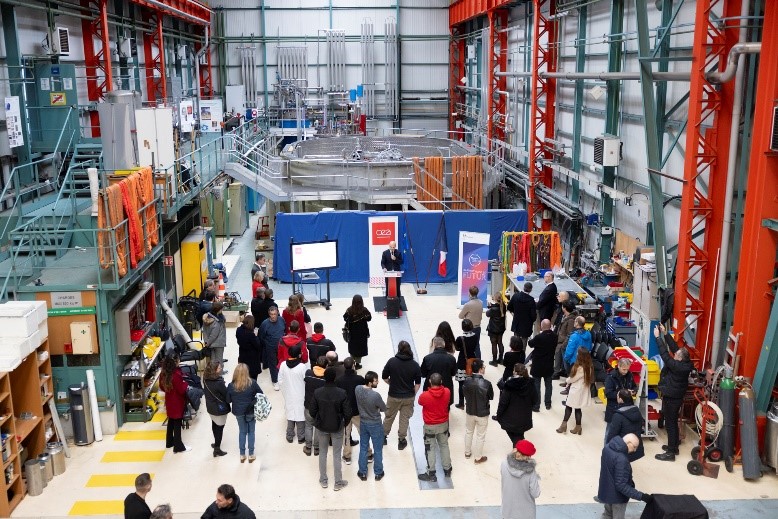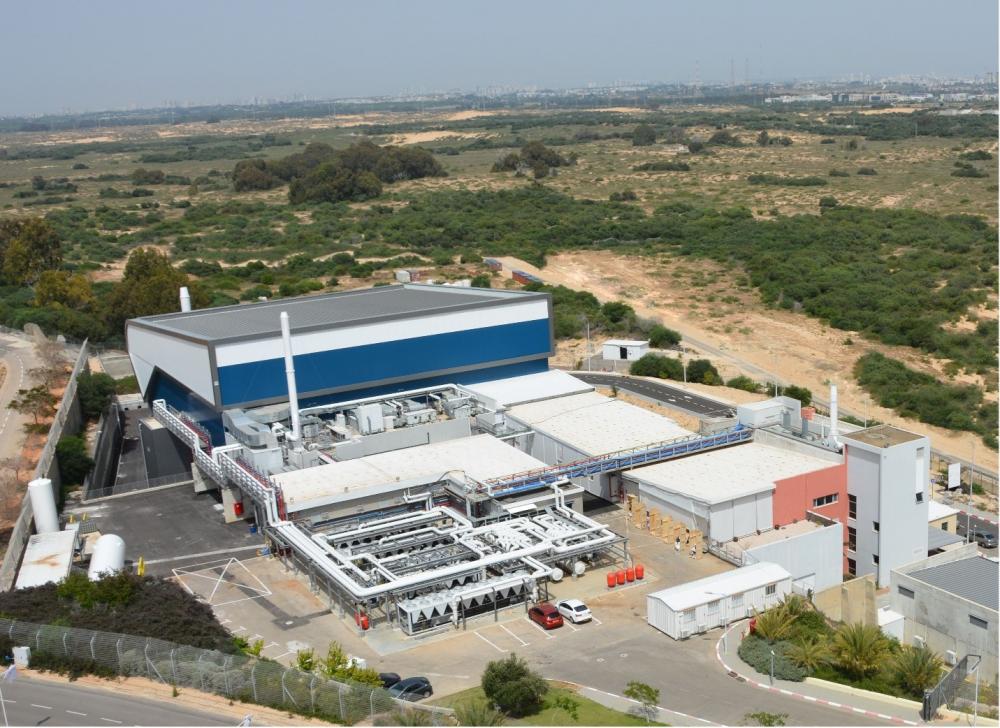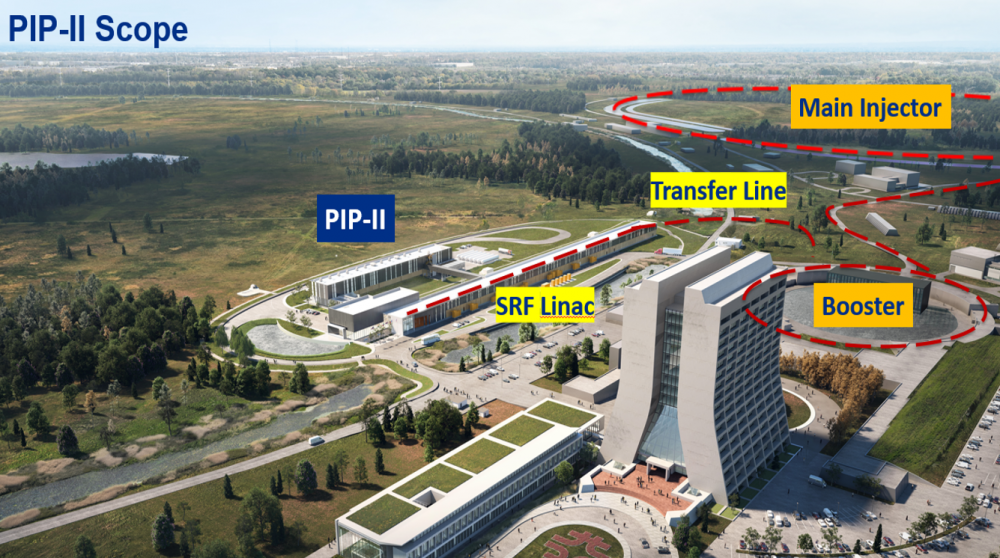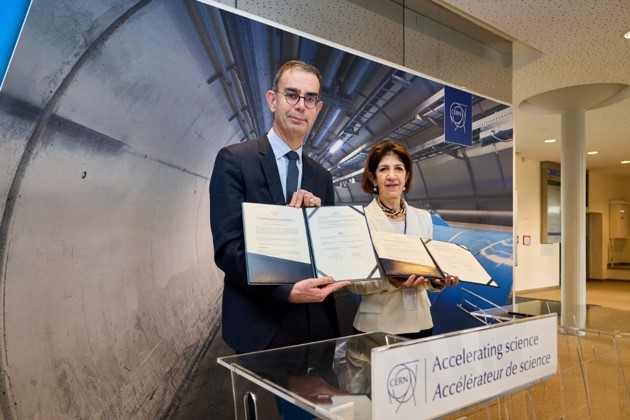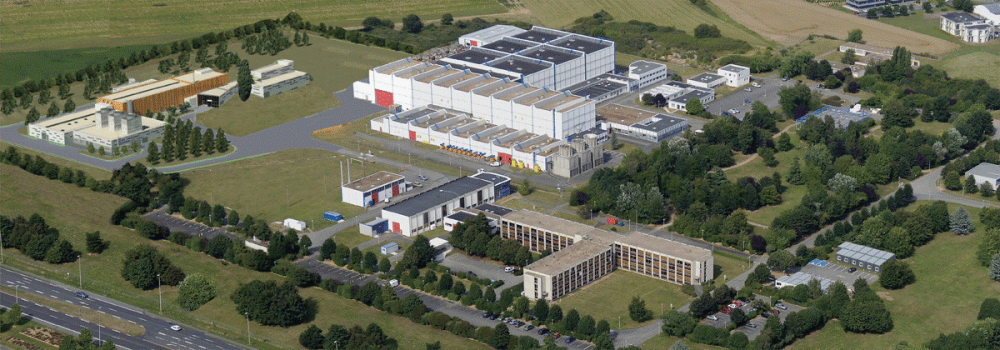Neutrino oscillations have confirmed that these mysterious particles have mass, contradicting the predictions of the Standard Model. The DPhP group at CEA/IRFU is seeking to solve this mystery by observing the very rare double-beta decay without neutrino emission of the Mo-100 nucleus using scintillating bolometers. Following the CUPID-Mo demonstration experiment at the Modane underground laboratory, the group has finalised a detailed background model that offers high precision for studying the 2v2β decay. The model thus achieves the lowest background index ever obtained by the scientific community for a 0ν2β bolometric experiment.
To achieve the target of 10-4 counts/keV/kg/year needed to detect this extremely rare decay, the CUPID experiment has also adopted a new detector technology: Nefanov-Trofimov-Luke (NTL) light detectors to improve background rejection. A measurement, using 10 identical light detectors coupled to Li2MoO4 and TeO2 crystals, was carried out at the Canfranc underground laboratory and demonstrated the applicability of this technology to CUPID detectors. Given the combination of low background, particle discrimination capability, high efficiency and high energy resolution, CUPID is recognised as one of the most promising next-generation 0ν2β search experiments. After a validation review, the experiment will begin its production and construction phase to obtain a complete detector from 2029.
The GBAR collaboration, to which the IRFU makes a major contribution, presented the results of its first data collection at CERN at the end of 2022 at the Moriond conferences in March 2023. For the first time, it observed the production of anti-hydrogen atoms resulting from the interaction of a beam of antiprotons supplied by CERN's Antiproton Decelerator (AD) and decelerated to an energy of 6 keV, with a cloud of positronium produced locally in the experiment. GBAR thus joins the very select club of experiments that have successfully synthesised anti-hydrogen atoms!
The ultimate aim of the GBAR experiment is to measure the acceleration of an anti-hydrogen atom in the Earth's gravity field, and compare it with that of ordinary matter. The Equivalence Principle, the basis of Einstein's General Relativity, states that all forms of matter and energy behave in the same way with respect to gravity. Since Galileo, falling-body experiments have tested this principle for different chemical elements of ordinary matter, confirming it with increasingly precise agreement. Recently, the MICROSCOPE satellite experiment verified it with a remarkable uncertainty of one part in 3x1015. But the action of gravity on antimatter has never yet been measured! Several indirect arguments suggest that antimatter should respect the Principle of Equivalence, and should therefore "fall" towards the Earth like matter. However, the relationship between matter and antimatter is intrinsically quantum, and the theory of gravitation does not sit well with quantum theory. So only experimental measurement can remove this doubt. Of course, the first step is to measure the sign, i.e. whether antimatter 'rises' while matter 'falls'. But even a small quantitative difference between the acceleration of antimatter and matter in free fall would be a revolution in physics
The ATLAS collaboration announced at the Moriond conference the observation of simultaneous production of four top quarks. This is one of the rarest and heaviest processes ever observed at the Large Hadron Collider (LHC). This measurement, coordinated by IRFU, allows to test the Standard Model of particle physics in its most complex predictions.
Reactor antineutrino anomalies are a decade-long puzzle in neutrino physics. They are manifested by deviations of the order of a few percent between measurements and predictions. These deviations have been observed in the number of antineutrinos measured by more than a dozen experiments at nuclear reactors, and in the shape of the kinetic energy distributions by the seven most recent ones. They could have been the way to a new physics beyond the standard model, but the recent experiments, including the STEREO experiment carried by IRFU, have closed this door.
In a work just published in Physical Review Letter [1], a team of physicists from IRFU and the Laboratoire National Henri Becquerel of DRT have shown that these anomalies could come from biases in the measurements of fission electrons used as a reference for the prediction. They have developed a beta strength function model to reduce the biases in the calculation of the energy spectra of electrons from fission of fissile reactor nuclei. The two "anomalies" on the antineutrino flux and the "bump" at 5 MeV in the antineutrino energy spectrum are now reproduced by their model. This allows to propose an explanation to solve an enigma of more than 10 years.
The final results of the Stereo experiment have just been published in the journal Nature. A record of precision is established for the spectrum of neutrinos emitted by the fission of 235U, measured between 9 and 11m distance from the ILL reactor core in Grenoble. The hypothesis of a sterile neutrino to explain the reactor neutrino anomaly is rejected. The quality of these direct neutrino measurements now surpasses that of the underlying nuclear data describing the beta decays of fission products. Stereo provides the community with a fission neutrino spectrum corrected for all detection effects, which will serve as a reference for future reactor experiments and points out residual biases in the nuclear databases.
The Stereo experiment has just completed a beautiful scientific adventure that began in 2011 with the revelation by the IRFU group of the "reactor antineutrino anomaly". Physicists were left with a significant deficit of 6% between the flux of neutrinos measured at the reactors and the predicted flux. The history of science has taught us enough about the potential richness of new phenomena that can hide behind an anomaly. What was going on here was the possible existence of a new type of neutrino that would open up a new area of physics beyond the standard model. Without any direct interaction with matter, this neutrino, described as "sterile", could however mix with "standard" neutrinos and thus leave an imprint of its existence through ... a deficit of count rate in our detectors.
The CEA and the DOE have a long and fruitful collaboration in many fields, including fusion, high-energy physics and nuclear physics, with ongoing projects bringing the two organisations together in these different areas.
On Monday 13 November 2023, CEA and DOE signed a “statement of interest” to strengthen their collaboration in accelerator and detector science and technology in preparation for the construction of the Electron-Ion Collider (EIC) based at Brookhaven National Laboratory.
Prediction of nuclear properties based on a realistic description of the strong interaction is the main quest of low-energy nuclear theory. One of the issues lies is the cost of solving Schrödinger’s equation that scales exponentially with the number of nucleons. Consequently, theoretical predictions based on first principles have long been limited to very light nuclei, to nuclei with specific proton and neutron numbers offering simplifications or to their ground states. While releasing each of these three constraints separately is ongoing, overtaking them at the same time constitutes the current forefront in the field. Employing a novel many-body formalism [1] recently developed by the PAN@CEA (“Problème à N corps au CEA”) collaboration (DRF-DAM-DES), the calculation of collective excitations, i.e. nuclear rotations and vibrations, in all medium-mass nuclei is envisioned for the first time [2,3]. This work paves the way to large-scale predictions of nuclear properties from first principles.
Reactor antineutrino anomalies are a decade-long puzzle in neutrino physics. They are manifested by deviations of the order of a few percent between measurements and predictions. These deviations have been observed in the number of antineutrinos measured by more than a dozen experiments at nuclear reactors, and in the shape of the kinetic energy distributions by the seven most recent ones. They could have been the way to a new physics beyond the standard model, but the recent experiments, including the STEREO experiment carried by IRFU, have closed this door.
In a work just published in Physical Review Letter [1], a team of physicists from IRFU and the Laboratoire National Henri Becquerel of DRT have shown that these anomalies could come from biases in the measurements of fission electrons used as a reference for the prediction. They have developed a beta strength function model to reduce the biases in the calculation of the energy spectra of electrons from fission of fissile reactor nuclei. The two "anomalies" on the antineutrino flux and the "bump" at 5 MeV in the antineutrino energy spectrum are now reproduced by their model. This allows to propose an explanation to solve an enigma of more than 10 years.
After several years of development at Saclay, the first part of the Falstaff spectrometer was moved to GANIL in 2021 and then installed on NFS for the study of uranium 235. The experiment that took place in November and December 2022 was the first to use an actinide target on SPIRAL2. It demonstrated the good performance of this device.
The final results of the Stereo experiment have just been published in the journal Nature. A record of precision is established for the spectrum of neutrinos emitted by the fission of 235U, measured between 9 and 11m distance from the ILL reactor core in Grenoble. The hypothesis of a sterile neutrino to explain the reactor neutrino anomaly is rejected. The quality of these direct neutrino measurements now surpasses that of the underlying nuclear data describing the beta decays of fission products. Stereo provides the community with a fission neutrino spectrum corrected for all detection effects, which will serve as a reference for future reactor experiments and points out residual biases in the nuclear databases.
The Stereo experiment has just completed a beautiful scientific adventure that began in 2011 with the revelation by the IRFU group of the "reactor antineutrino anomaly". Physicists were left with a significant deficit of 6% between the flux of neutrinos measured at the reactors and the predicted flux. The history of science has taught us enough about the potential richness of new phenomena that can hide behind an anomaly. What was going on here was the possible existence of a new type of neutrino that would open up a new area of physics beyond the standard model. Without any direct interaction with matter, this neutrino, described as "sterile", could however mix with "standard" neutrinos and thus leave an imprint of its existence through ... a deficit of count rate in our detectors.
On November 8, 2023, ESA's Science Program Committee (SPC) approved the evolution of the Athena (Advanced Telescope for High-Energy Astrophysics) mission, now named NewAthena, and confirmed its status as the flagship mission of ESA's Cosmic Vision program.
Positioned as a pioneer in X-ray astrophysics for the coming decades, NewAthena will enable the astronomical community to make major scientific advances in our understanding of the hot, energetic universe. Key scientific themes include the evolution of the universe's structures, the growth and impact of supermassive black holes through cosmic time, and many other astrophysical fields for which the NewAthena X-ray observatory will provide unique data.
Formal adoption of NewAthena is scheduled for 2027, with a view to launch in 2037.
Barbara Perri, an astrophysicist at Irfu's Astrophysics Department and an expert in space weather, has been awarded an ANR contract for the WindTRUST project, which aims to predict solar activity in order to protect against it.
The WindTRUST project is based on improved numerical simulations of the environment between the Sun and Earth, in particular the still poorly understood link between the Sun's magnetic atmosphere and its fast-moving wind of energetic particles.
An international team led by French researchers, including those at DAp, publishes on November 28, 2023 in the Astrophysical Journal a compilation of 340 pulsars seen in gamma rays (30 MeV - 30 GeV) with the LAT space telescope on NASA's Fermi satellite.
Prior to Fermi's launch in 2008, only 11 pulsars were known in gamma rays. This new catalog brings together all the characteristics of all known gamma-ray pulsars. It contains a wealth of information on the mechanisms, poorly understood today, by which pulsar beams are generated. This wealth of centralized information will help theorists explore new avenues in their quest to understand these phenomena.
Astrophysical Journal Supplement 2023, Smith et al, The Third Fermi Large Area Telescope Catalog of Gamma-ray Pulsars
Antoine Strugarek, an astrophysicist in Irfu's Astrophysics Department, has been awarded an ERC Consolidator contract. The core of his ExoMagnets project is to understand the magnetic coupling between an exoplanet and its star, and therefore the magnetic field of exoplanets, which is crucial for the habitability of a planet.
The aim of the ExoMagnets project is to develop new theories and high-performance simulations using future exa-scale computing infrastructures in order to exploit existing and future observations of the magnetism of distant exoplanets.
The consortium of laboratories that has developed the MIRI instrument for the JWST is benefiting from guaranteed observation time. The CEA's Astrophysics Department, which is part of the consortium, has defined and coordinated the exoplanet observation programme. Among the objects selected are a number of brown dwarfs, which are excellent proxies for studying giant exoplanets, particularly those that orbit far from their star, much further away than the planets in our solar system. The physical and chemical processes that govern brown dwarfs are very similar. The first results concerning the cold brown dwarf W1828 have just been published in the journal Nature. By pointing the James Webb Space Telescope (JWST) at this object, a team of researchers including DAp-AIM researchers were able to use the MIRI instrument to measure, for the first time, the isotopologues of ammonia in the atmosphere of a cold brown dwarf, paving the way for a better understanding of the formation of exoplanets.
These results have been published in the journal Nature.
ESA has selected the THESEUS (Transient High Energy Sky and Early Universe Surveyor) mission as a medium-sized mission candidate. THESEUS is the natural successor to the Sino-French SVOM (Space based astronomical Variable Object Monitor) mission, which will be launched early 2024 (for 5 years of operation) and in which IRFU is also playing a leading role.
THESEUS has been chosen from among 27 missions, along with Plasma Observatory (study of the Earth's magnetosphere) and M-MATISSE (study of the atmosphere and magnetosphere of Mars), for a preliminary study lasting three years (2024-2026), at the end of which one of the three missions will be carried out for launch in 2037.
CEA/IRFU will play a leading role in the mission, as the PI of the international consortium (which includes INAF and Politecnico Milano in Italy, University of Geneva in Switzerland, and LAM Marseille and IJClab Orsay in France) responsible for developing and delivering one of the three satellite's instruments: the IRT (Infra-Red Telescope) and more specifically the camera placed at its focus.
To reveal the influence of the dark components of the Universe, over the next six years Euclid will be observing the shapes, distances and movements of billions of galaxies. This mapping will cover periods going back to the last 10 billion years of cosmic history, in order to gain a better understanding of where, when and how dark energy and matter - two key components of the universe that are still a mystery - act.
As a prelude to the mission, it was decided to illustrate the satellite's scientific and instrumental capabilities through a series of images of the nearby Universe. Jean-Charles Cuillandre, an astronomer in CEA/IRFU's astrophysics department, led this 'ERO' (Early Release Observations) campaign over several months, with a group of scientists from the Euclid collaboration and ESA, from the choice of the five astrophysical sources to image processing, from raw data to analysed images, combining the responses of the VIS (visible light) and NISP (near infrared) instruments.
An international team of scientists, including a researcher from Irfu's Astrophysics Department, used several space and ground-based telescopes, including the James Webb Space Telescope and the European Southern Observatory's Very Large Telescope, to observe an exceptionally bright gamma-ray burst detected on March 7, 2023, GRB 230307A, and identify the neutron star merger that generated the explosion responsible for the burst. In particular, the Webb telescope enabled scientists to detect the chemical element tellurium in the aftermath of the explosion. This discovery supports the hypothesis that neutron star mergers are one of the main sources of production and expulsion into the interstellar medium of some of the heaviest elements known in the Universe.
These results were published in Nature on October 25, 2023 (Levan et al.).Heavy element production in a compact object merger observed by JWST | Nature
For the 17th edition of the Prix Jeunes Talents France, the L'Oréal Foundation rewarded 35 brilliant young female researchers in France, selected from 618 eligible applications by a jury of excellence comprising 32 researchers from the French Academy of Sciences. At Irfu's Astrophysics Department, Achrène Dyrek received the award for physics.
Achrène Dyrek has just obtained her PhD in astrophysics. She began her thesis in 2020 at CEA's Department of Astrophysics (DAp), under the supervision of Pierre-Olivier Lagage. During this time, she dedicated herself to the study of planetary atmospheres as seen by the James Webb Space Telescope (JWST - NASA/ESA/CSA), using the MIRI (Mid-InfraRed Instrument) developed at DAp.
Fermi-LAT telescope continues systematic γ-ray survey
NASA's Fermi satellite was launched in June 2008, and the Fermi-LAT telescope has been carrying out a systematic γ-ray survey of near-GeV energies covering most of the sky every 3 hours (and the whole sky in no more than a week) since August 2008.
The question of our place in the Universe - "where are we in the Universe?" - is a fascinating one, and the source of one of the oldest sciences: Cosmography, the mapping of the Cosmos. Using a method based on the study of the velocity fields of galaxies measured by different telescopes, cosmographers - a team of researchers from the CEA, the University of Hawaii and the University of Queensland - reconstruct the cosmic web of our nearby Universe and reveal its architecture, revealing large structures of superclusters of galaxies, but also large voids, shaped by gravitation [1].
Daniel Pomarède, from Irfu, has been in charge of mapping Cosmicflows catalogues and displaying them in 3D and interactively since 2010. Between 2014 and today, their catalogue has grown from 8,000 to 56,000 galaxies, and the map is expanding with the inclusion of a catalogue of galaxies measured by the SDSS collaboration [2].
With their latest Cosmicflows-4 catalogue, they have just discovered an immense bubble of galaxies, a new fossil from the beginnings of our Universe, dating from the same period as the cosmic microwave background radiation. This is the first time that a remnant of a wave, witness to the primordial universe, has been measured individually in the distribution of galaxies.
These results have just been published in The Astrophysical Journal.
“Ho’oleilana: An Individual Baryon Acoustic Oscillation?” by R. Brent Tully, Cullan Howlett, and Daniel Pomarède, The Astrophysical Journal, Volume 954, Number 2 https://doi.org/10.3847/1538-4357/aceaf3
The Euclid satellite, launched from Cape Canaveral on July 1st, is traveling to reach its orbit at the second Lagrange point, which it should reach in early August. This transit time has been used to commission Euclid, checking the satellite's services such as communications, power, and pointing, and then the two instruments, VIS and NISP, as well as fine-tuning the telescope's focus. The instrument teams have just released the first "raw" images (untreated) to mark the success of instrument commissioning.
Marc Sauvage (astrophysicist at DAp/Irfu and one of the two French representatives on the Euclid consortium council): "These images perfectly match what we had simulated, but in a simulation, we know that everything we see was deliberately placed there, so in a way, it's not surprising. Here, everything we see is real, and nothing we see was known at this level of detail; it makes us want to look into every corner, to enlarge everything to see as much detail as possible. And since there is a tremendous amount of detail in just these two images, it becomes dizzying!"
Michel Berthé (Euclid project leader at DAp/Irfu): "I am truly amazed by the beauty of these images and the amount of information that can be found in them. We are only at the very beginning of the analysis of these initial results, but they are already very promising.
All the teams at CEA who have worked for more than 10 years on the design, production, and testing of the elements we have provided for the VIS and NISP instruments are particularly proud of these initial results, which demonstrate the nominal operation of our supplies as well as the entire satellite."
Using the James Webb Space Telescope, a group of astronomers led by MPIA, in collaboration with a team from the Astrophysics Department of CEA Paris-Saclay, searched for an atmosphere on the rocky exoplanet TRAPPIST-1 c. Although the planet is almost identical to Venus in terms of size and mass, its atmosphere turned out to be very different. By analyzing the heat emitted by the planet, they concluded that it may have only a tenuous atmosphere containing a minimum of carbon dioxide. However, this is also consistent with a barren rocky planet devoid of any significant atmosphere. This work gives us a better understanding of how the atmospheres of rocky planets orbiting low-mass stars can withstand strong stellar winds and intense UV radiation.
The results are presented in the journal Nature:
The Universe is immensely big, and getting bigger all the time. To study dark energy, the mysterious force behind the accelerating expansion of our Universe, scientists are using the large Dark Energy Spectroscopic Instrument (DESI) survey to map over 40 million galaxies, quasars and stars. Today, the collaboration has released its first batch of data, with nearly 2 million astrophysical objects for researchers to study. It is also publishing 15 papers on the scientific study of these data, and on the instrument, operations and validation of the survey observation strategy.
The data set (80 terabytes) comes from 2,480 exposures taken over six months during the so-called "survey validation" phase in 2020 and 2021 and processed in Python language on the supercomputer at the National Energy Research Scientific Computing Center (NERSC, Berkeley, USA). During this period, between the instrument's commissioning and the start of the official scientific campaign, researchers ensured that the instrument's performance would meet their scientific objectives - for example, by checking the time needed to observe galaxies of different luminosities, and validating the selection of astrophysical objects such as galaxies, quasars and stars to be observed.
Read the Berkeley press release : https://newscenter.lbl.gov/2023/06/13/desi-early-data-release-holds-nearly-two-million-objects/
On October 9, 2022, at 13:16 and 59.99 seconds, a gamma-ray burst (GRB) dazzled almost all the X-ray and gamma ray detectors available at the time. Since their discovery, multi-wavelength telescopes in space and on the ground have continuously monitored these events. This outburst, named GRB221009A, shook the world community of astrophysicists, who have since been analysing it to understand the physical phenomena that triggered this most intense burst of energy in our history.
|
|
X-rays detection due to the scattering of light from the initial explosion of GRB 221009A by the dust of our galaxy, has led to the formation of expanding rings. This "movie" (in arbitrary colors) shows these rings formed by X-rays detected by NASA's Swift telescope. It was created by combining images captured over a 12-day period. Credit A. Beardmore, University of Leicester, NASA, Switf |
Discovered in 2009, exoplanet GJ1214b orbits a small star just 40 light-years away. With a mass around six times that of Earth and an atmosphere made up of hydrogen and helium, it is considered a "mini-Neptune".
A team from NASA, in collaboration with researchers from CEA Paris-Saclay, pointed the JWST at the planet using the MIRI instrument, built by CEA Paris-Saclay, for some 40 hours. This unprecedented observation made it possible to obtain, for the first time, the phase curve of an exoplanet with MIRI, i.e. complete tracking of the planet's rotation around its star.
By following the evolution of the exoplanet-star system's emission, the research team was able to determine the planet's temperature to within 9°: 280°C on the dayside and 164°C on the night side. Comparing the observations with atmospheric models, the researchers deduce that: 1. the small temperature difference between the two sides, despite the planet's synchronous rotation, means that there is a good exchange of energy between the sides, due to a dense atmosphere. 2. The relatively low temperature on the dayside, given the planet's proximity to its star, indicates that a layer of aerosols in the exoplanet’s upper atmosphere reflects much of the stellar radiation. The type of aerosol with such a property has yet to be determined. 3. The atmosphere contains many elements heavier than hydrogen and helium, probably abundant water.
The results are published in the prestigious journal Nature
The European Research Council has just announced the names of the winners of the Advanced Grant. This 2023 edition rewards in particular two researchers from the CEA's fundamental research department for their work in the fields of astrophysics and neuroscience. Anaëlle Maury is the leader of the PEBBLES project. This project consists of developing an innovative methodology to characterise the properties of dust around very young stars in the process of forming their proto-planetary disks. Dust is one of the key elements in the physical processes regulating the formation of stars and their planetary systems, but recent observations are overturning the models used until now to describe its evolution from submicron grains to pebbles. Observing and modelling the properties of dust grains during the earliest phases of disk formation promises to provide important insights into the conditions leading to the formation of solar systems such as our own. Through PEBBLES, the teams will use new dust models that are better suited to denser astrophysical environments and will use them in comparison with observations from space missions and ground-based observatories from the infrared to the millimetre range.
An international team of researchers has used NASA's James Webb Space Telescope to measure the temperature of the rocky exoplanet TRAPPIST-1 b. This is the world's first detection of thermal emission from a rocky exoplanet as small and “cool” as the rocky planets in our own solar system. TRAPPIST-1 b receives about twice the amount of energy as Venus receives from the Sun and four times more than Earth. The result indicates that the dayside of the planet has a temperature of about 227°C (500 K) and suggests that it has no significant atmosphere. The study, co-authored by three researchers from the Dap, has just been published in the journal Nature, on Monday 27 March.
Magnetars are neutron stars known for their wide variety of electromagnetic emissions coming from the dissipation of their extreme magnetic fields, which are the strongest known in the Universe and can reach 1015 Gauss, or 10 billion times that of the strongest magnet created by humans.
How could these magnetic fields have been formed? This is one of the open questions that a Franco-German team led by the supernovae team of the Department of Astrophysics (DAp) of CEA Paris-Saclay, has recently tried to answer by proposing a numerical modeling of a new scenario of formation of magnetars in a study published in the scientific journal "Astronomy and Astrophysics".
This scenario suggests that the matter falling on the neutron star a few seconds after its formation can trigger a dynamo effect called Tayler-Spruit which would amplify its magnetic field, and this independently of its initial rotation speed. The simulations of this scenario reproduces the measured intensity of magnetar magnetic fields. Therefore, this study represents another step towards the understanding these atypical objects.
CEA has delivered to CNES the flight version of the ECLAIRs instrument software for the SVOM satellite. This concludes a major instrumental development phase conducted by CEA over a period of 6 years to produce what is maybe one of the most complex software packages ever carried on a French scientific space instrument. The latest version of the software equips the ECLAIRs onboard computer, which departed to China in early 2023. It will be used during the satellite integration tests in Shanghai in preparation for the launch planned for early 2024. This software will analyse in real time the data from the instrument in flight, in order to detect gamma-ray bursts and localise them to better than 12 arcmin on the sky, to reorient automatically the satellite for follow-up observations, and to alert the scientific community.
Large ground-based telescopes with mirrors over 8 m in diameter1 use azimuthal mounts to point the stars. When tracking a star, the Earth's rotation causes the observed field on the astrophysics detector to rotate, creating "spun" images. To correct this effect, the instruments mounted on these telescopes use a "field derotator", a mechanism whose main function is to rotate a set of mirrors at very low speed and with very high precision. For the METIS instrument, CEA-Irfu has developed one of the world's very first2 derotators operating at -210°C. Entirely designed, developed and tested by the Irfu Systems Engineering Department, the METIS derotator drive achieves performance beyond the expected specifications. Currently in the testing phase, its qualification will be completed by the end of 2023 at ESO in Garching, Germany.
While the use of field derotation mechanisms is relatively common in ground-based astrophysics instruments, most scientific communities choose to place this mechanism upstream of the cryogenic instrument, so that it operates at ambient temperature. Doing this way, the required levels of accuracy (of the order of a few thousandths of a degree) are achieved using 'standard' components such as motorised stages, optical encoders, ball bearings and lubricated gearboxes.
To reduce the instrumental background noise, the METIS instrument of the future ELT will be entirely cooled down to temperatures around -210°C, so the field derotation mechanism will also have to operate at these temperatures in vacuum.
The commissioning of the 11.7 T Iseult MRI in 2021 crowned almost 20 years of AOC research and development. In an article published in the journal Magnetic Resonance Materials in Physics, Biology and Medicine, Nicolas Boulant and Lionel Quettier, Iseult project leaders for the CEA's Joliot and Irfu Institutes, review the details of this commissioning.
CEA has delivered to CNES the flight version of the ECLAIRs instrument software for the SVOM satellite. This concludes a major instrumental development phase conducted by CEA over a period of 6 years to produce what is maybe one of the most complex software packages ever carried on a French scientific space instrument. The latest version of the software equips the ECLAIRs onboard computer, which departed to China in early 2023. It will be used during the satellite integration tests in Shanghai in preparation for the launch planned for early 2024. This software will analyse in real time the data from the instrument in flight, in order to detect gamma-ray bursts and localise them to better than 12 arcmin on the sky, to reorient automatically the satellite for follow-up observations, and to alert the scientific community.
Engineers from Irfu's Division of Systems Engineering (DIS), co-managers of several EPICS sub-projects, took part in a particularly rewarding "Document-athon" experience, both technically and humanely.
EPICS is a collection of open-source software tools for managing the control-system part of an experiment. This is a vast and complex subject, which is constantly evolving and therefore needs to be properly documented. This documentation effort requires a lot of resources. The Document-athon aims to bring EPICS contributors together, physically and virtually, and work on various topics related to the EPICS documentation. It is also a unique opportunity to share ideas with colleagues from all over the world on a wide range of subjects: common problems, working methods, technical solutions (adopted or under study), etc.
The docs.epics-controls.org website now centralizes almost all EPICS tools and aims to become the central/preferred location for its documentation.

A scientist from IRFU published an article in the Physical Review A presenting a diffraction model based on the concept of quantum measurement [1]. This model represents a new approach because the amplitude of the diffracted wave is usually calculated using classical methods of wave optics. Several specific effects of the quantum aspect of the model are predicted, three of which can be the subject of experimental tests: a typical damping of the light intensity at large diffraction angles, an angular factor different from that of classical theories and a characteristic parameter of a link between the polarization and the momentum of the diffracted photons. Experiments carried out at IRAMIS in the coming months will make it possible to simultaneously measure the momentum and polarization of the detected photons and thus validate or not the proposed model.
Low-temperature superconducting materials are widely used in high-field magnets, but their behaviour is closely related to the strains they undergo. Consequently, studies on the impact of stress on mechanical structures are essential. The SUPRAMITEX project is participating in this research effort by using the AMITEX-FFTP parallel code developed as part of the SIMU/MATIX project to carry out non-linear mechanical simulations on heterogeneous microstructures. This work has shown the interest of the AMITEX code to simulate the mechanical behaviour of these components, at different scales, for elastic and elasto-plastic behaviours at simulation scales that were previously unattainable.
The PEPR Suprafusion (Priority Equipment Programme for Exploratory Research), proposed by CEA and CNRS, is the winner of the third wave of calls for projects under the France 2030 plan. The €50 million funding will enable the development of high-temperature superconductors to meet tomorrow's energy and societal challenges, particularly with applications in the field of fusion. The programme is based on 3 axes: the development of the technological building blocks of HTS (high-temperature superconductors), the large-scale demonstration of technological feasibility and the exploration of breakthrough applications.
Thanks to the expertise developed by the CEA during the SPIRAL2 and IFMIF projects, in 2014 the CEA signed a contract with the Soreq Nuclear Research Centre (SNRC, Israel) to build a superconducting linear accelerator called SARAF (Soreq Applied Research Accelerator Facility). The aim is to build an accelerator capable of delivering proton and deuteron beams with energies ranging from 5 to 40 MeV and intensities of up to 5 mA. This equipment will be an important tool for fundamental research, particularly in nuclear physics, the characterisation of materials using neutrons and the production of medical radioisotopes. The CEA is responsible for the design, manufacturing and qualification of 5 sub-assemblies: the MEBT and the 4 cryomodules of the linear accelerator. In 2023, the CEA qualified the MEBT, which was delivered in 2020, and delivered the first cryomodule to Soreq.
The PIP-II (Proton Improvement Plan-II) project is the first particle accelerator to be built in the United States with major in-kind contributions from international partners. CEA/IRFU provides its expertise in the field of superconducting radio-frequency cryomodules and associated technologies. CEA/IRFU has been involved in this project since 2018, with a major contribution to the LB650 superconducting accelerator section, including the design studies, manufacture, and qualification of 10 cryomodules (each of them housing 4 superconducting accelerating cavities), i.e. 1 pre-production cryomodule and the 9 production cryomodules of the accelerator. A major milestone in the CEA/IRFU project was reached in April 2023, with the final design review of the LB650 cryomodule, validating 5 years of design activities. The project is now entering the pre-production cryomodule construction phase.
The commissioning of the 11.7 T Iseult MRI in 2021 crowned almost 20 years of AOC research and development. In an article published in the journal Magnetic Resonance Materials in Physics, Biology and Medicine, Nicolas Boulant and Lionel Quettier, Iseult project leaders for the CEA's Joliot and Irfu Institutes, review the details of this commissioning.
The recent update of the European Strategy for Particle Physics recommended a feasibility study for the future generation of collider. In this context, the Laboratory Directors Group, of which IRFU is a member, has been mandated by the CERN Council to oversee the development of an accelerator R&D roadmap. One of the objectives of this roadmap is the development of technologies for the manufacture of high-field superconducting magnets, essential for future colliders: this is the HFM (High Field Magnets) project.
The MADMAX project, which was launched in November 2016, is led by the Max Planck Institut für Physik in collaboration with several European institutes. The goal of the project is the discovery of axions with a mass of about 100 µeV, potential candidates for dark matter. To detect these axions, it is necessary to develop a specific detector consisting of an electromagnetic signal amplifier and a magnet proportional to the size of the amplifier and delivering a strong magnetic field. In order to validate the innovations in the fabrication of the magnet conductor, its cooling concept and the quench detection, a demonstrator has been designed, fabricated, integrated and tested between March 2020 and August 2021. It is named MACQU for MADMAX Coil for Quench Understanding. The entire design, from the conductor to the support structure, including the MACQU magnet, its thermal shield and the busbars, was carried out at the CEA. The demonstrator, manufactured by the industrial Bilfinger Noell GmbH, arrived in March 2021 and was successfully tested between May 18 and August 27, 2021. The analysis of the data now completed provides the desired answers and opens up unexpected new avenues of work. The feasibility of the cable concept, its cooling as well as the quench detection for the MADMAX magnet was demonstrated during these tests.
The commissioning of the 11.7 T Iseult MRI in 2021 crowned almost 20 years of AOC research and development. In an article published in the journal Magnetic Resonance Materials in Physics, Biology and Medicine, Nicolas Boulant and Lionel Quettier, Iseult project leaders for the CEA's Joliot and Irfu Institutes, review the details of this commissioning.
Low-temperature superconducting materials are widely used in high-field magnets, but their behaviour is closely related to the strains they undergo. Consequently, studies on the impact of stress on mechanical structures are essential. The SUPRAMITEX project is participating in this research effort by using the AMITEX-FFTP parallel code developed as part of the SIMU/MATIX project to carry out non-linear mechanical simulations on heterogeneous microstructures. This work has shown the interest of the AMITEX code to simulate the mechanical behaviour of these components, at different scales, for elastic and elasto-plastic behaviours at simulation scales that were previously unattainable.
The recent update of the European Strategy for Particle Physics recommended a feasibility study for the future generation of collider. In this context, the Laboratory Directors Group, of which IRFU is a member, has been mandated by the CERN Council to oversee the development of an accelerator R&D roadmap. One of the objectives of this roadmap is the development of technologies for the manufacture of high-field superconducting magnets, essential for future colliders: this is the HFM (High Field Magnets) project.
The MADMAX project, which was launched in November 2016, is led by the Max Planck Institut für Physik in collaboration with several European institutes. The goal of the project is the discovery of axions with a mass of about 100 µeV, potential candidates for dark matter. To detect these axions, it is necessary to develop a specific detector consisting of an electromagnetic signal amplifier and a magnet proportional to the size of the amplifier and delivering a strong magnetic field. In order to validate the innovations in the fabrication of the magnet conductor, its cooling concept and the quench detection, a demonstrator has been designed, fabricated, integrated and tested between March 2020 and August 2021. It is named MACQU for MADMAX Coil for Quench Understanding. The entire design, from the conductor to the support structure, including the MACQU magnet, its thermal shield and the busbars, was carried out at the CEA. The demonstrator, manufactured by the industrial Bilfinger Noell GmbH, arrived in March 2021 and was successfully tested between May 18 and August 27, 2021. The analysis of the data now completed provides the desired answers and opens up unexpected new avenues of work. The feasibility of the cable concept, its cooling as well as the quench detection for the MADMAX magnet was demonstrated during these tests.
The PEPR Suprafusion (Priority Equipment Programme for Exploratory Research), proposed by CEA and CNRS, is the winner of the third wave of calls for projects under the France 2030 plan. The €50 million funding will enable the development of high-temperature superconductors to meet tomorrow's energy and societal challenges, particularly with applications in the field of fusion. The programme is based on 3 axes: the development of the technological building blocks of HTS (high-temperature superconductors), the large-scale demonstration of technological feasibility and the exploration of breakthrough applications.
On 23 June 2023, GANIL (Grand Accélérateur National d'Ions Lourds), one of the world's leading laboratories for research using ion beams, obtained building permission for the future DESIR experimental room, part-funded by an Equipex. The permit authorises the launch of construction work, starting with deep earthworks in July 2023, with the aim of taking delivery of the building in spring 2025. The first experiments are expected by 2027, providing the nuclear physics, fundamental interaction physics and nuclear astrophysics communities with a unique and internationally competitive research platform.
The MADMAX project, which was launched in November 2016, is led by the Max Planck Institut für Physik in collaboration with several European institutes. The goal of the project is the discovery of axions with a mass of about 100 µeV, potential candidates for dark matter. To detect these axions, it is necessary to develop a specific detector consisting of an electromagnetic signal amplifier and a magnet proportional to the size of the amplifier and delivering a strong magnetic field. In order to validate the innovations in the fabrication of the magnet conductor, its cooling concept and the quench detection, a demonstrator has been designed, fabricated, integrated and tested between March 2020 and August 2021. It is named MACQU for MADMAX Coil for Quench Understanding. The entire design, from the conductor to the support structure, including the MACQU magnet, its thermal shield and the busbars, was carried out at the CEA. The demonstrator, manufactured by the industrial Bilfinger Noell GmbH, arrived in March 2021 and was successfully tested between May 18 and August 27, 2021. The analysis of the data now completed provides the desired answers and opens up unexpected new avenues of work. The feasibility of the cable concept, its cooling as well as the quench detection for the MADMAX magnet was demonstrated during these tests.

